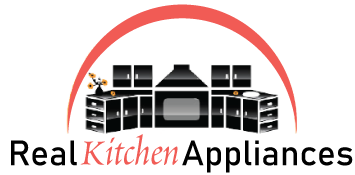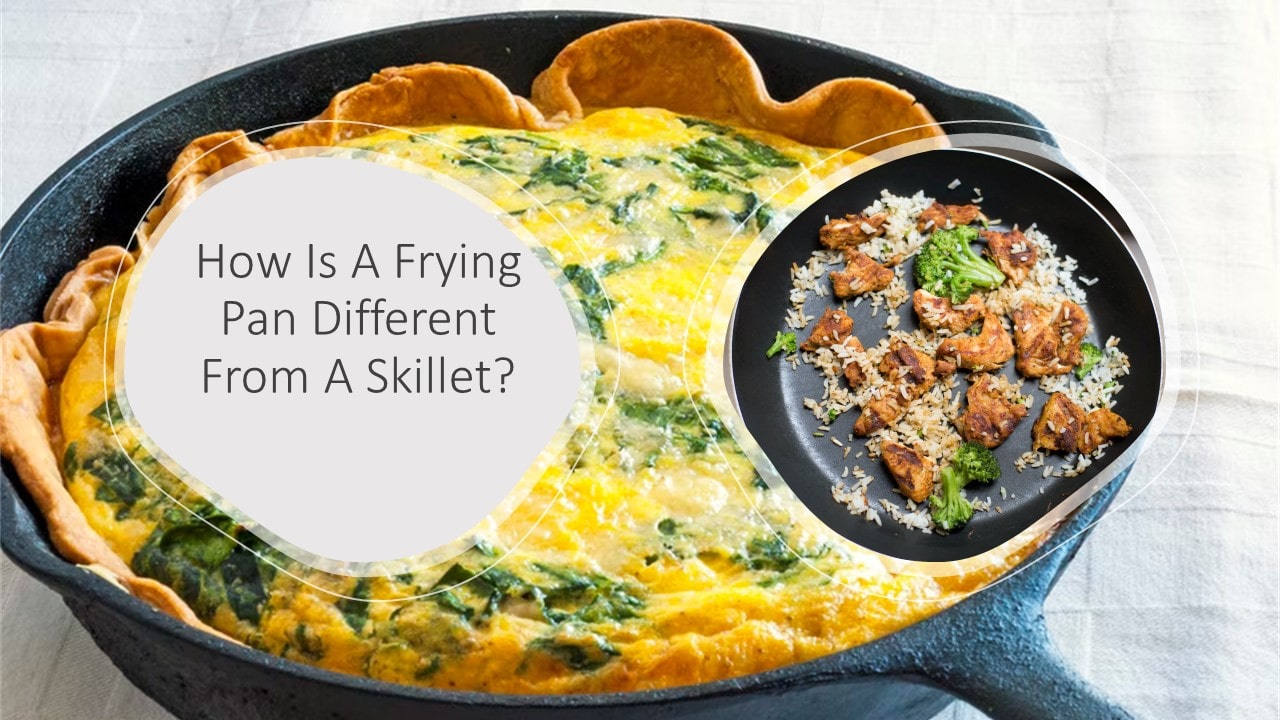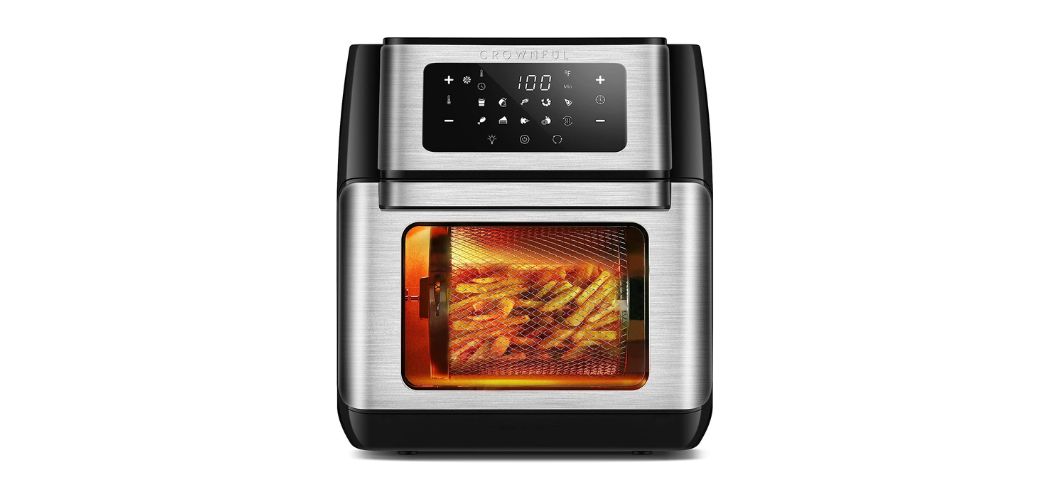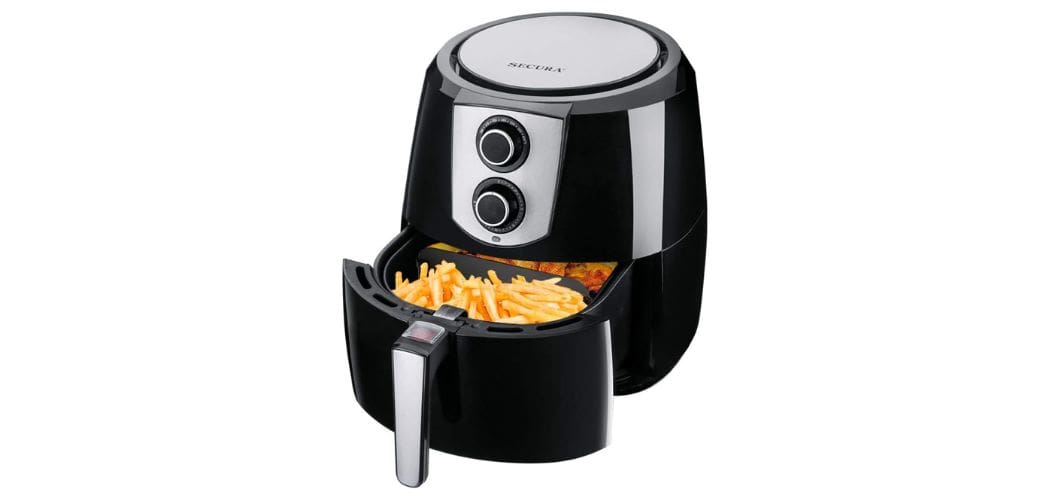A person may cook in various ways, including placing the meal directly over a fire or storing it in a pot and heating it later. Some vessels may hold all of the ingredients based on how you will prepare the dish.
In ancient times, tree leaves and mud pots held onto food while preparing delicious dishes. Then man discovered additional materials and used them in kitchen utensils to keep food warm. Cookware evolved into the contemporary varieties that you observe and use today.
But what are the two basic kitchen utensils that everyone uses? Yes, they are frying pans and skillets. Even though they are comparable and perform the same activities, they are distinguished by several factors. Read on to know about the factors that set them apart.
Table of Contents
What Is A Frying Pan?
A frying pan has a smooth bottom that evenly distributes heat throughout its surface.
As a result, the food may reach the desired temperature in the shortest time while maintaining an even temperature across the pan.
With a frying pan, you can achieve the same consistency and flavour as deep frying since just a tiny quantity of oil is required for frying.
Usually, manufacturers use a variety of high-quality metalcore materials to make this pan.
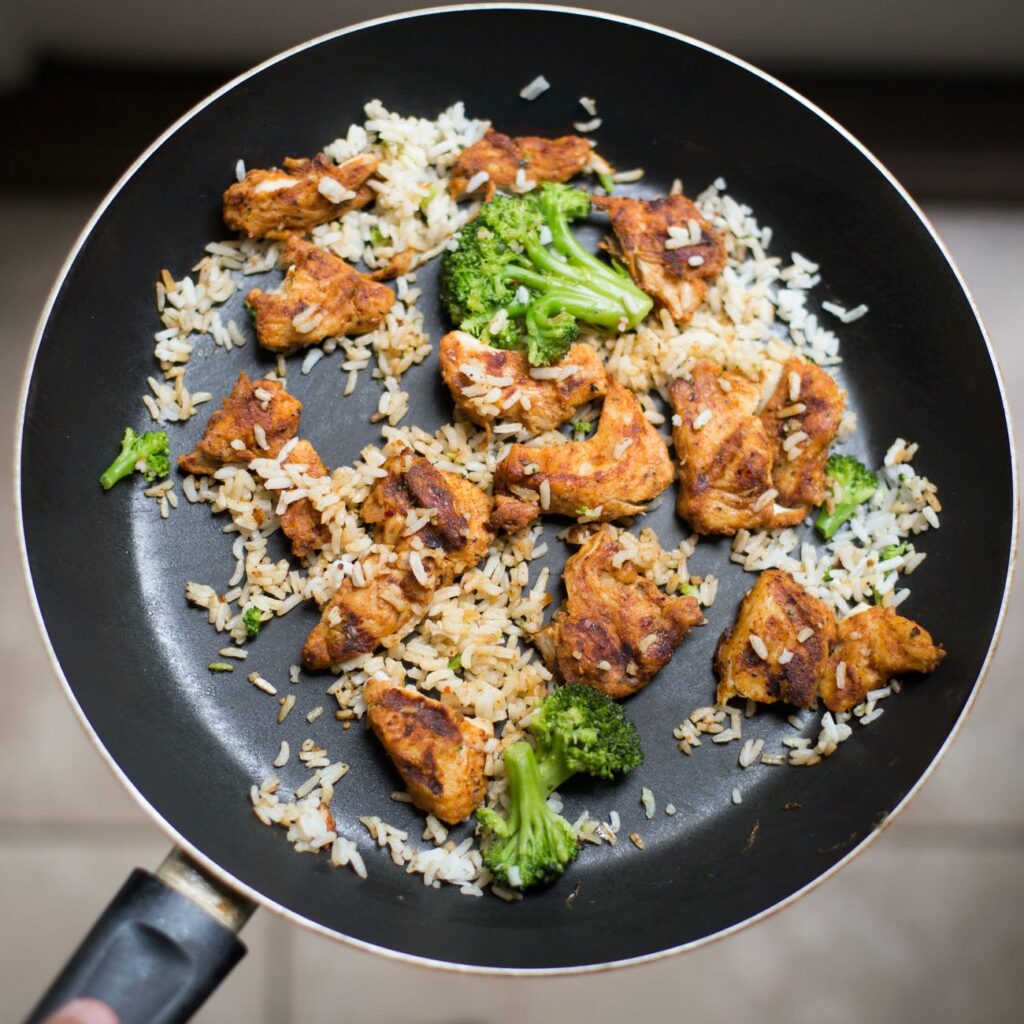
To provide uniform heating and non-stick coating, the bottom is significantly flat. The frying pan’s dispersed sides make it easier to glide over the food and prevent steam from condensing in one spot, allowing it to cook quickly. Characteristics of a frying pan are:
Quick Function:
Skillets are thicker than frying pans. As a result, they heat up rapidly and cook meals in a shorter time. Furthermore, since frying pans have a larger cooking surface, you may spread the food out and cook it faster.
Low-Maintenance:
Given its synthetic non-stick coating, frying pans do not need seasoning like skillets. They should be cleaned as you would any other cookware and lightly scraped to avoid scratching the non-stick covering, but that’s all.
Durable Cooking Surface:
Since they are made of materials like stainless steel, most frying pans feature scratch-resistant cooking surfaces.
Offers More Flavour:
Foods prepared in a frying pan do not fall short in terms of taste. Even though the dish is cooked rapidly, it retains the taste.
Use Less Oil:
Non-stick surfaces are standard on frying pans. This implies that you may cook in a frying pan with less oil. Frying pans are a terrific alternative if you want a kitchenware item that provides healthier foods and isn’t worried about an iron deficit.
What Is A Skillet?
Even though skillets and frying pans are sometimes used interchangeably, skillets were initially deeper than saucepans. You can recognise a skillet with its slanted sides.
Because of the diagonal edges, this pan is excellent for stir-frying.
It is also employed in quick-cooking methods like constantly moving items around in a pan.
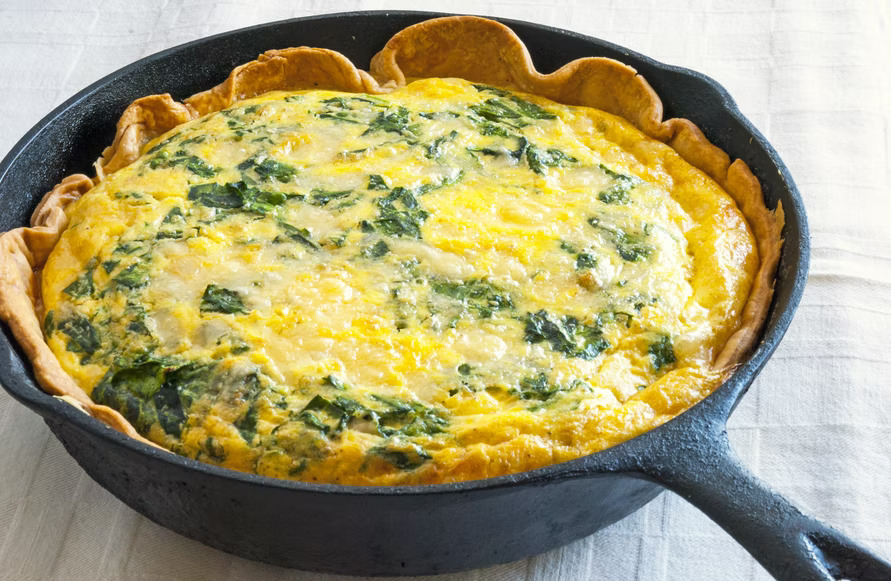
Moreover, a skillet is also fantastic for pan-fried dishes like frittatas. The only significant change is the form of the sides, which is the same as the diameters.
Sure, one utensil may be more adapted to specific jobs than the other, but that doesn’t imply the other can’t perform the same. Some characteristics of a skillet are:
Non-Stick:
Most skillets are essentially non-stick. However, please note that to retain this level of excellence, you must carefully season your pan. This is the process of applying a protective coating of oil to the skillet’s surface.
You don’t need any chemical coatings to make cast iron non-stick since it can create a non-stick coating with particular oil.
Beneficial For Health:
As strange as it may seem, cooking on a skillet is healthful. Not only does it not leach pollutants from artificial coatings, but it also adds iron to your meals.
Retention Of Heat:
Skillet can often take a long time to heat up, but it also takes a long time to cool down. You may cook and serve your food in the pan if you want it to remain warm for longer.
Oven-Friendly:
The heat capacity of a skillet is relatively high. As a result, you may bake it without fear of damaging your pan. Cast iron skillets are ideal for slow-cooking foods in the oven since they are entirely safe.
You might never bake cornbread or carrot cake any other way after trying it in a cast iron pan.
Lasting:
If properly cared for, skillets will last a lifetime. They improve use as the porous surface softens due to consistent cooking with a good spatula.
Skillet vs. Frying Pan: What’s The Difference?
Weight:
Frying pans have a more extensive base and diameter than regular skillets, making them heavier. This is why, in addition to the primary handle, they include a “helping handle” that aids in moving and raising the frying pan across the burner.
Skillets are smaller and lighter, with just one long grip. They’re safe to use and move about on the stove. Don’t worry about the weight as long as the pans sit on the burner. When you want to mix or shake the ingredients, though, a skillet is less convenient.
A frying pan is preferable if you want your chicken and vegetables to cook evenly. On the other hand, a deep skillet is ideal for tender meat meals that keep all of their sauces and spices.
Cooking Capacity:
A frying pan’s tall, straight sides enable you to fill it with more liquids.
As a result, it is ideal for cooking curries, stews, pies, and thick gravies.
You’re less likely to spill or splatter the liquids with clean, tall sides, which may be an issue with skillets.
When simmering any sauce over a skillet, its plain bottom and narrow angled-out sides might generate spillage.
When shallow-frying, the increased capacity of a frying pan comes in handy.
Although any pan would suffice, the extra volume will guarantee that your meat browns evenly, even with just a few teaspoons of oil.

Skillets, on the other hand, have their own set of benefits. It is ideal for making pancakes, omelettes, dry stir-fry, and frittatas. It holds less oil and produces outstanding cuisine because of the equal dispersion of heat.
Surface Area:
The pan’s surface area increases or decreases by the diameter of its lip. A 12-inch-diameter frying pan will, by definition, have a larger cooking surface.
The width of a skillet is an inch less than that of a frying pan. This implies that skillets get a 20-30% smaller cooking surface.
As a result, if you want to slow-cook chicken thighs in wine, a frying pan may be the ideal choice. Skillets work well when you’re just cooking a few items at once. Instead of grilling your food in batches, cook it all at once in a frying pan.
Ability To Toss:
The reality is that a skillet is significantly better at braising and tossing food.
No doubt, a frying pan does a good job, but things are more seamless with a skillet.
A skillet’s slanted, broader sides enable the food to curve about without spilling out.
Since the walls of a frying pan are vertical and straight, this is not possible.
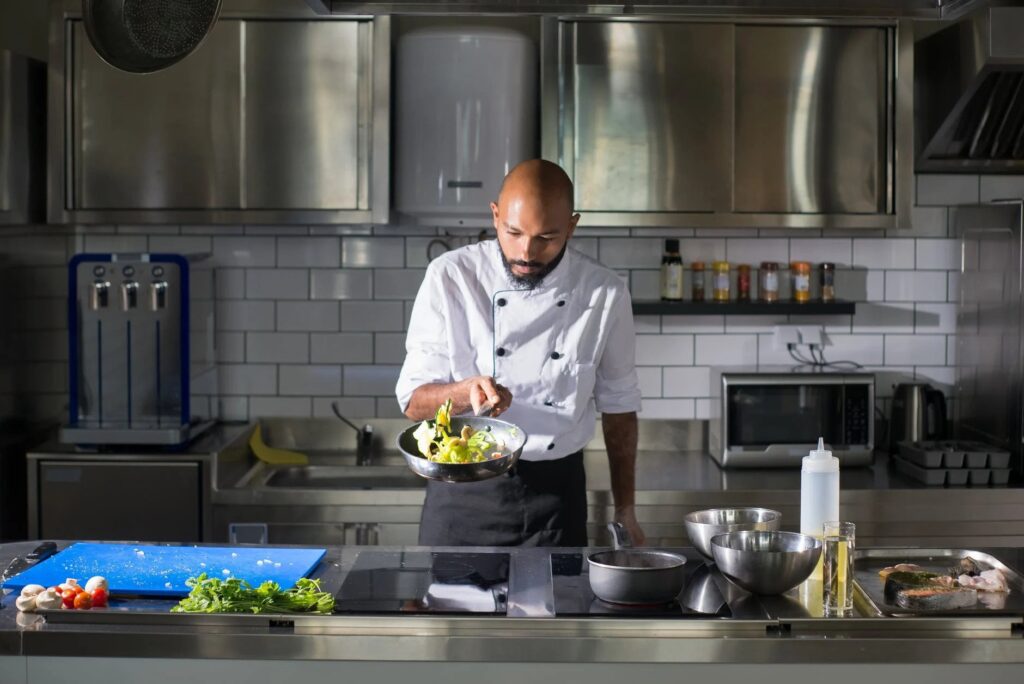
Skillets provide more tossing capabilities, whether you want to show off a “chef-style” manoeuvre or mix your food around.
A frying pan is better for meals like Béchamel gravy or chicken and noodles stew, which need periodic and mild stirring. If you’re stirring, be sure to use a wooden paddle to avoid scratching the pan’s surface.
Rate Of Evaporation:
Managing the humidity in your food is the key to perfect cooking. The shape of a pan may have a significant impact on how much water your food retains. A skillet has a flatter cooking surface, which aids in the reduction of sauces.
Although a frying pan has a wide surface area, it is not an excellent option for evaporating moisture. On the other hand, a frying pan is useful for saucy recipes in which the food must be juicy and tender.
Quick Comparison Guide:
| Aspects | Skillet | Frying pan |
| Weight | Lighter and thinner | Heavier and thick |
| Cooking capacity | Less liquid hold with more chance of spilling | Fills more liquid and less spillage |
| Area | Less surface area | More surface area |
| Toss | Better at tossing | Not as good because of the thickness |
| Evaporation | More evaporation | Less evaporation |
FAQs
What Are French skillets?
French skillets are comparable to skillets or frying cookware in appearance. They have a somewhat different shape, being a bit broader and deeper than skillets. It allows for a broader and deeper cooking surface. Consider them a blend of a skillet and a frying pan.
What Cooking Pans Do Culinary Chefs Use?
When it comes to pans, professional cooks usually emphasise quality and durability. They like pans that are flexible and easy to manage in crowded kitchens, so solid metal and porcelain cookware are popular choices.
What Are Cast-Iron Skillets?
The cast-iron skillet is by far the most popular skillet due to its durability and long-lasting nature. It will survive for years if properly cared for and maintained.
If you use a cast-iron pan, you’ll need to season it frequently to keep your food from sticking. Aside from that, it’s a solid, simple-to-use one-time purchase with longer handles.
What’s The Verdict?
The type of food you prepare most often determines which cooking equipment is ideal for you. Take a look at your daily menu to determine what kind of items are most frequent.
If you like comfort meals like stews and casseroles and want an incredibly flexible cookery item, a skillet is the way to go.
However, if you’re looking for a pan to cook fast meals, the frying pan is the way to go. Cleaning and using steel frying pans is a breeze.
Also, think about the size of the pan you’re purchasing. Pick a good smaller pan if you only cook one or two pieces often. If you often cook for a big group, a larger pan will be helpful.
